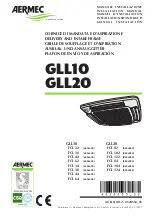
En-4
Do not use copper pipes that have a collapsed, deformed, or discolored portion (es-
pecially on the interior surface). Otherwise, the expansion valve or capillary tube may
become blocked with contaminants.
Improper pipe selection will degrade performance. As an air conditioner using R410A
incurs pressure higher than when using conventional refrigerant, it is necessary to
choose adequate materials.
Thicknesses of copper pipes used with R410A are as shown in the table.
•
Never use copper pipes thinner than those indicated in the table even if they are avail-
•
able on the market.
Thicknesses of Annealed Copper Pipes (R410A)
Pipe outside diameter [mm (in.)]
Thickness [mm]
6.35 (1/4)
0.80
9.52 (3/8)
0.80
12.70 (1/2)
0.80
15.88 (5/8)
1.00
19.05 (3/4)
1.20
4.2. Pipe requirement
CAUTION
Refer to the Installation Manual of the outdoor unit for description of the length and the
diameter of connecting pipe or for difference of its elevation.
Use pipe with water-resistant heat insulation.
•
CAUTION
Install heat insulation around both the gas and liquid pipes. Failure to do so may cause
water leaks.
Use heat insulation with heat resistance above 120 °C. (Reverse cycle model only)
In addition, if the humidity level at the installation location of the refrigerant piping is
expected to exceed 70 %, install heat insulation around the refrigerant piping.
If the expected humidity level is 70-80 %, use heat
insulation that is 15 mm or thicker and if the expected humidity exceeds 80 %, use
heat insulation that is 20 mm or thicker. If heat insulation is used that is not as thick as
speci
fi
ed, condensation may form on the surface of the insulation.
In addition, use heat insulation with heat conductivity of 0.045 W/(m·K) or less (at 20 °C).
4.3. Flare connection (pipe connection)
4.3.1. Flaring
Use special pipe cutter and
fl
are tool exclusive for R410A.
•
Cut the connection pipe to the necessary length with a pipe cutter.
(1)
Hold the pipe downward so that cuttings will not enter the pipe and remove any burrs.
(2)
Insert the
fl
are nut (always use the
fl
are nut attached to the indoor and outdoor units
(3)
respectively) onto the pipe and perform the
fl
are processing with a
fl
are tool.
Leakage of refrigerant may result if other
fl
are nuts are used.
Protect the pipes by pinching them or with tape to prevent dust, dirt, or water from
(4)
entering the pipes.
L
Die
Pipe
Check if [L] is
fl
ared uniformly
and is not cracked or scratched.
Pipe outside diameter
[mm (in.)]
Dimension A [mm]
Dimension B
-
0
0.4
[mm]
Flare tool for R410A,
clutch type
6.35 (1/4)
0 to 0.5
9.1
9.52 (3/8)
13.2
12.70 (1/2)
16.6
15.88 (5/8)
19.7
19.05 (3/4)
24.0
When using conventional
fl
are tools to
fl
are R410A pipes, the dimension A should be ap-
proximately 0.5 mm more than indicated in the table (for
fl
aring with R410A
fl
are tools) to
achieve the speci
fi
ed
fl
aring. Use a thickness gauge to measure the dimension A.
Width across
fl
ats
Pipe outside
diameter [mm (in.)]
Width across
fl
ats of
Flare nut [mm]
6.35 (1/4)
17
9.52 (3/8)
22
12.70 (1/2)
26
15.88 (5/8)
29
19.05 (3/4)
36
B-3. Installing Brackets
Install the bracket with nuts, spring washers.
Ceiling panel
Special nut A
(Accessories)
Bracket
M10 Nut (Field supply)
M10 Nut (Field supply)
Spring washer
(Field supply)
Bracket (Left)
Bracket (Right)
B-4. Installing indoor unit
Reset the hex bolts as shown in the
fi
gure
Indoor unit
Hex bolt
8 to 13
Unit : mm
Apply the indoor unit to the brackets.
Bolt
Bracket
Indoor unit
Now, securely tighten the hex bolts in both sides.
3.3.3. Barrier and RFM base removal and installation
Remove the barriers by removing the 4
fi
xing screws (2 screws each).
(1)
Remove the RFM base by removing the 2
fi
xing screws and unhooking the 1 hook.
(2)
After completing the work, install the barriers and RFM base as they were originally.
(3)
Fixing screw
(2 positions)
Barriers
RFM base
Hook
Fixing screw
(2 positions)
Install the barriers in the correct direction.
4. PIPE INSTALLATION
CAUTION
Be more careful that foreign matter (oil, water, etc.) does not enter the piping than with
refrigerant R410A models. Also, when storing the piping, securely seal the openings by
pinching, taping, etc.
While welding the pipes, be sure to blow dry nitrogen gas through them.
4.1. Selecting the pipe material
CAUTION
Do not use existing pipes.
Use pipes that have clean external and internal sides without any contamination which
may cause trouble during use, such as sulfur, oxide, dust, cutting waste, oil, or water.
It is necessary to use seamless copper pipes.
Material : Phosphor deoxidized seamless copper pipes It is desirable that the amount
of residual oil is less than 40 mg/10 m.
9374318445-05_IM.indb 4
4/6/2012 10:08:16 AM

































